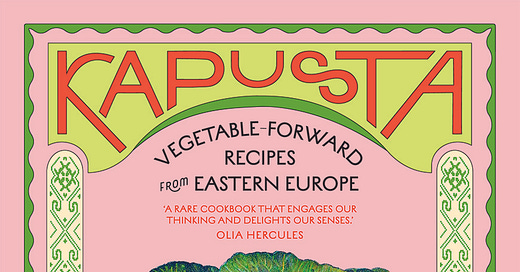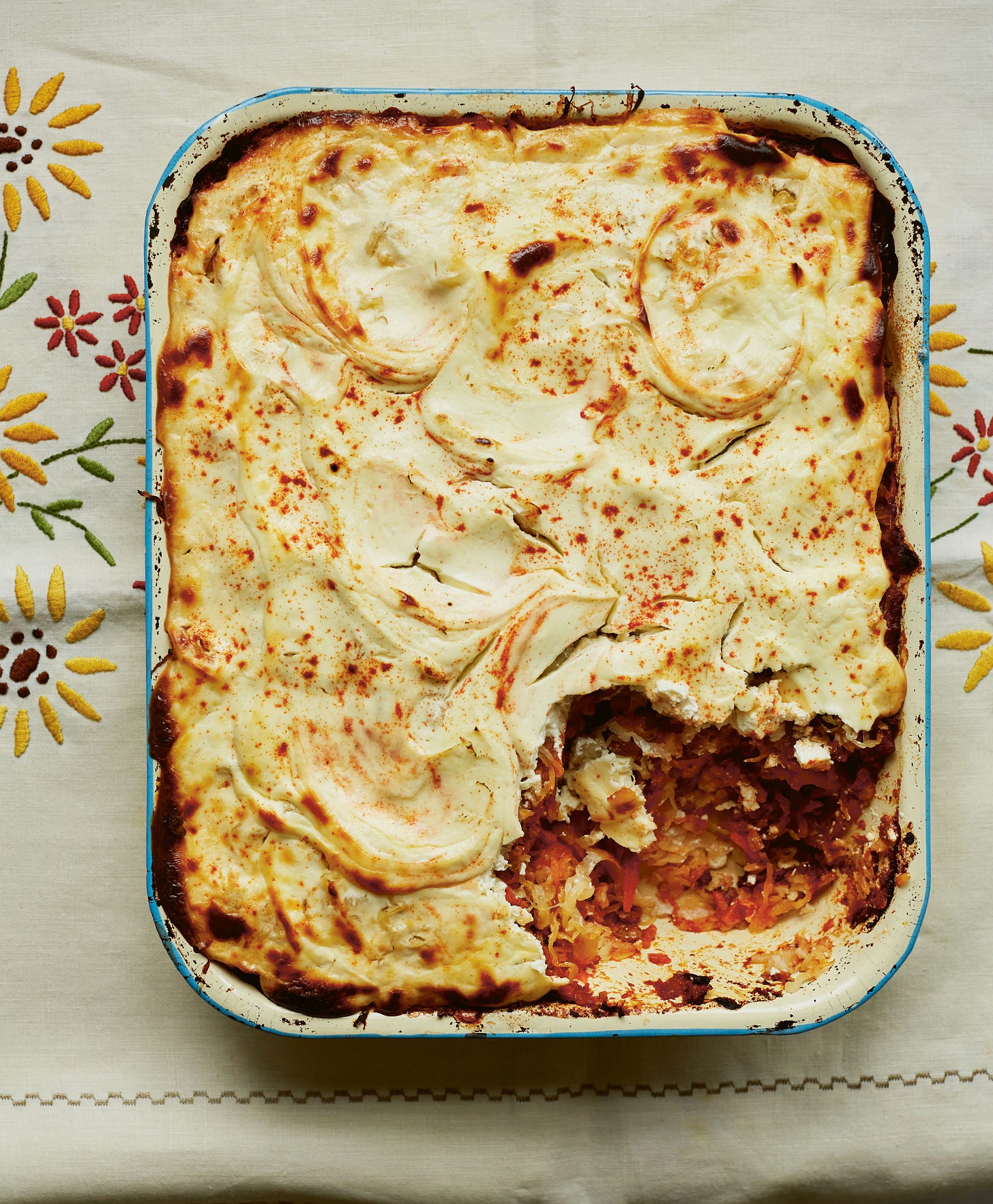Good Things #8 | Kapusta
Vegetable-forward recipes from Eastern Europe, in a beaut of a book by Alissa Timoshkina
I can tell you from personal experience that an odd mixture of emotions stir when a cookbook writer is told how beautiful their new book looks, how stunning the photos, how glorious the cover.
The inevitable comments made when others first see your new baby (or at the announcement of it) are understandable. And indeed a few small burps of gratitude and pride do rise up.
But, but, but also: what about the smart, snappy, educational and highly cookable recipes?! The painfully extruded yet ultimately pitch perfect prose!
Yet I still made exactly those comments when arriving at the house of Alissa Timoshkina a few months ago, for a lunch to mark the publication of her latest book, Kapusta — an involuntary gasp, and then “wow Alissa, such as beautiful cover. Congratulations!”
Just look at it, though. Did you ever think you’d want to hug a cabbage?
Off the screen and in your hands the book is even more covetable and tactile. The poster-worthy horticultural illustrations by Emma Wells (at Nic+Lou) of its core subjects (cabbage, beetroot, dumplings, potatoes, carrots, mushrooms, pickles and ferments) are beguiling; the food and portraits (and the light) captured by photographer Laura Edwards is arresting, quietly comforting and transportive.
But but but the recipes and words!
Happily, eating the feast prepared by Alissa and her Mum moved reactions towards the recipes.
Dips, slaws, knishes (Ashkenazi buns with potatoes and sour cream), ferments and a prune, apricot and carrot cake bookended a couple of dishes that I’m so pleased to be able to extract in this newsletter:
Varza A La Cluj, a Romanian Sauerkraut, ground meat and grains bake, which deserves to be as well-known, loved and repeatedly cooed as Greek Moussaka, and ‘80s Britain’s Cottage pie; and
a SUPERB gratin of cabbage and fennel wedges, braised in cream, which she offers as something that could be both a side or a centrepiece.
(also below for paid subscribers: a recipe carrot, honey and sweet cheese fritters; and an opportunity to win a copy of Kapusta.)
It was a memorable meal. The best kind of beige food, dotted with bright oranges and purples, all underpinned and seasoned with soul, integrity and an appreciation of how food and fuel evolves into cuisine and identity.
I’ve spent much time with Kapusta since then. The cover and photography are still arresting, of course, but the words and recipes are bolder now. As soon as I come up to breathe from a project of my own I will cook a glut of Alissa’s recipes — dumplings of all shapes and sizes, plump pastries and pies, ferments and cabbage rolls, meals coloured by smoky paprika and lifted by sour cream and fresh herbs. She skilfully shows that there is commonality across Poland, Belarus, Czech Republic, Slovakia, Hungary, Romania, Moldova, Bulgaria and Ukraine, but that those countries, regions and peoples, and their food, are diverse too. It is a book that will delight and warm anyone with even a hint of a link to Eastern Europe; and open the minds and palates of others from beyond.
Kapusta really is beautiful — and it would be even without the cover and photos. Alissa’s introductory writing and context setting is considered and clever, her collation of traditional recipes and her own twists are smart, thoughtful and pragmatic.
In the face of Putin’s aggression and Trump’s acquiescence, Kapusta feels timely and important — there’s a pertinent map of Eastern Europe at the beginning — and Alissa writes hopefully in her introduction
“to me, the fact that Eastern Europe withstood the conquests and saw the fall of many once-powerful empires, from the Roman to the Soviet, raising up each time with a renewed sense of pride and value of ones origin and history, speaks of courage, resourcefulness, endurance and freedom. And this is something that is intricately reflected in the cuisine of the region”.
A compelling book to cook from, to read, and yes, to look lovingly at. Do consider it.
Kapusta: Vegetable-forward recipes from Eastern Europe, by Alissa Timoshkina, photography by Laura Edwards. Quadrille.
Just quickly before we move to the recipes, two other soon to be published books of note that I look forward to reading:
Olia Hercules’ Strong Roots: A Ukrainian Family Story of War, Exile and Hope.
Felicity Spector’s Bread and War: A Ukrainian Story of Food, Bravery and Hope.
Recipes from Kapusta, by Alissa Timoshkina
Varza A La Cluj – Romanian Sauerkraut, Meat and Grains Bake
“There are endless possibilities for how you can use cabbage, meat and grains, and Eastern European cuisine presents us with just that. If I have cabbage, some type of grain and minced (ground) beef or mushrooms in my kitchen, I take comfort in the thought of just how many nourishing and delightful dishes I could make. Varza a la Cluj is a Romanian classic, not too dissimilar in flavour and ingredients to the cabbage rolls we’ve explored on the previous pages. However, this is a speedy, fuss-free version that requires no rolling and folding. The dish is believed to have originated in one of Transylvania’s largest cities, Cluj, in the late 1600s, and it has been a widespread staple ever since. While this version is a meat one, have a look on page 52 for an alternative mushroom filling. I will also offer a choice of grains here, because who doesn’t love an easy, nourishing and adaptable dish?”






